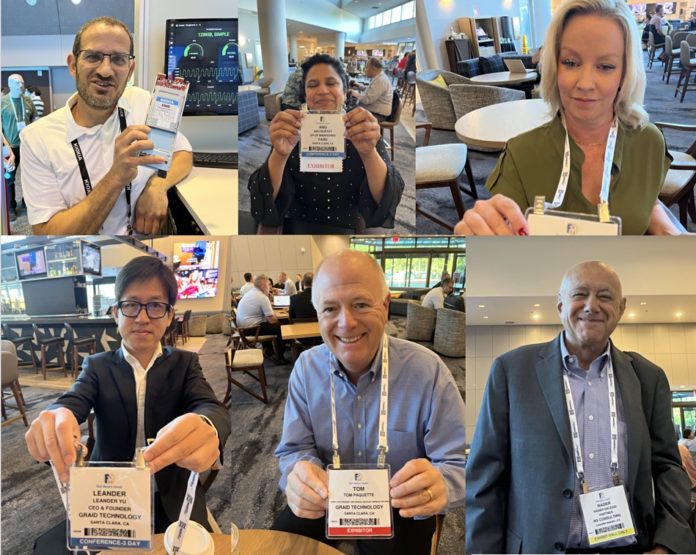Some three thousand people from the flash and SSD supply industry gratefully met at the Flash Memory Summit 2022 in the Santa Clara convention Centre this week – the first FMS summit for two years due to the great COVID convention shutdown.
The vibe was overwhelmingly positive. Attendees were pleased to be there, to be part of the flash community, and there was a strong sense of everyone associating together for the greater good of the flash and SSD ecosystem. Sure, there were pretty direct questions in some of the many sessions, but there was obvious respect on the part of both question asker and question answerer. Everyone, it appeared, was simply glad to be there and taking part.
The summit focus was on suppliers in the flash and SSD ecosystem, not end users. But any end users who did attend enjoyed an unrivalled opportunity to look into the heart of the technology developments.
These were centred on CXL, computational storage, the post-Optane situation, and an astonishing amount of development in the number of types of SSD, the componentry for CXL, and hardware to make flash more effective as a hot data store – and also a cold data store, surprisingly. That came in the shape of a 128TB – yes 128TB – Samsung archive SSD.
We have already reported on some developments: SK hynix’s 238-layer flash; SK hynix announced CXL 2 memory cards and SDK–CXL memory device; Solidigm’s neat FOB-extending P41 Plus client SSD; Phison and Seagate unveiling super high-performance stats for their PCIe 4 SSD; and, in a very well-timed move, OpenCAPI merging with the CXL organization.
There was one single negative event: the ousting of the founders of computational storage startup NGD amidst funding round troubles. Computational storage (CS) has its supporters and its critics. One of the latter told me CS is crumbling around the edges. Another said CS has to be programmable and needs a killer app, which it lacks. Hardware-enabled compression and encryption is not computational storage – it’s relatively trivial hardware acceleration. Good as far as it goes – which is not very far at all.
But CS partisans were many, and pointed to Pliops and ScaleFlux product advances, Solidigm signalling it’s interested, IBM flash module support, and SK hynix support. More suppliers are piling into the CS market than are getting out, but opinion is still divided – unlike CXL.
MemVerge led a CXL charge, with a whole day of presentations and panel sessions. It was accompanied by suppliers announcing CXL memory componentry and general support. The general thrust is that CXL is a great and good technology. It has a large and strengthening supplier ecosystem and wide industry support. I heard not one single negative CXL sentiment during the summit.
Optane’s departure has been met with a sentiment best described as “glad it’s over” – the technology’s demise had become almost certain following the killer blow of Micron withdrawing from 3D XPoint fabrication and selling off its Lehi fab. The prospect of any other supplier spending $5 billion to convert an existing fab – or $10 billion, $15 billion or more to build a greenfield 3D XPoint fab – is ridiculous. It isn’t going to happen.
The gap in the memory storage hierarchy that was plugged by Optane will be filled from below by faster SSDs – Neo’s multiplying SSD plane technology looked highly relevant to this. And it will be filled from above, for customers that can afford the high prices and low density, by MRAM and other resistive RAM technologies. The central area in this gap looks likely to stay unfilled – because there is no affordable and fast enough storage-class memory technology in existence.
Right, says the flash industry. Optane is over and done with. We’ll make do with memory expansion via pooling DRAM on CXL v2 and 3. Move on.
There were standout technology advances. For example: NeuroBlade and its GPU-style processors and hyper-compute for analytics; GRAID and its AI-style processor plus optimizing the whole digital data supply chain between flash and processors; FADU and its controller promising greased lightning PCIe 5 SSDs.
There was a small explosion in new kinds of SSD: Kioxia’s gen 2 XL-FLASH; SK hynix’s key-value store SSD; Samsung’s memory-semantic SSD, archive SSD, and smart SSD.
Winbond was there, reminding everybody NOR flash has a role to play in every smart device. Yangtze Memory Technology was there, secretive almost to a fault about its X3-9070 v3 Xtacking product or technology. What is the flash cell layout inside? Is it QLC or TLC? We can’t say. How many layers does it have? We can’t say. There have been reports you are developing 196 ad 232-layer flash? No comment. Will these be co-ordinated with Xtacking v3 and v4? We can’t say.
This reticence contrasted with the general openness seen with the other suppliers, all of whom were keen to present their technology and explain how it worked.
The funniest stand was Ontrack, with its drive recovery technology and a battered, burnt and broken notebook as its prime exhibit:

The Flash Memory Summit is a community of suppliers all working for the greater good of the industry. This rising-tide-lifts-all-boats atmosphere was refreshing – it’s not something I’ve seen at other storage shows, such as VMworld or similar supplier events. All FMS 2022 attendees were believers in the flash religion, if I could put it like that, and the industry is in a very positive and solid state.








